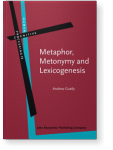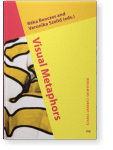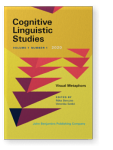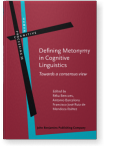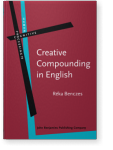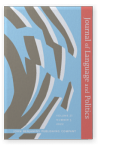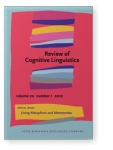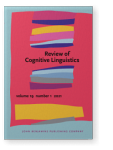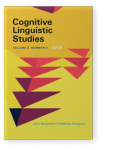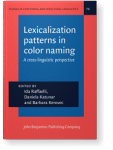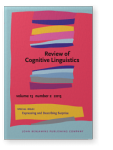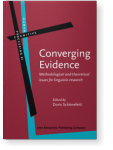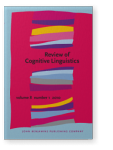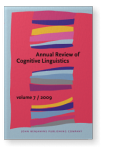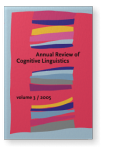Réka Benczes
List of John Benjamins publications for which Réka Benczes plays a role.
Book series
Visual Metaphors
Edited by Réka Benczes and Veronika Szelid
[Benjamins Current Topics, 124] 2022. vi, 284 pp.
Subjects Cognition and language | Cognitive linguistics | Theoretical literature & literary studies
Visual Metaphors
Edited by Réka Benczes and Veronika Szelid
Special issue of Cognitive Linguistic Studies 7:1 (2020) vi, 274 pp.
Subjects Cognition and language | Cognitive linguistics | Cognitive psychology | Neurolinguistics | Psycholinguistics
Defining Metonymy in Cognitive Linguistics: Towards a consensus view
Edited by Réka Benczes, Antonio Barcelona and Francisco José Ruiz de Mendoza Ibáñez
[Human Cognitive Processing, 28] 2011. viii, 284 pp.
Subjects Cognition and language | Cognitive linguistics
Creative Compounding in English: The Semantics of Metaphorical and Metonymical Noun-Noun Combinations
Réka Benczes
[Human Cognitive Processing, 19] 2006. xvi, 206 pp.
Subjects Cognitive linguistics | English linguistics | Germanic linguistics | Semantics
2022 Migrants are not welcome: Metaphorical framing of fled people in Hungarian online media, 2015–2018 Journal of Language and Politics 21:3, pp. 413–434 | Article
Figurative framing, in the form of metaphorical expressions, is especially effective in carrying conceptual content on an issue and affecting public opinion. One topic that has been heavily debated in contemporary Hungarian media is migration. Framing starts with the label that journalists… read more
2022 Onomatopoeia and metonymy Living Metaphors and Metonymies, Brdar, Mario and Rita Brdar-Szabó (eds.), pp. 195–209 | Article
When it comes to onomatopoeia, it is often claimed that such words are the epitome of sound symbolism, as the link between form and meaning is felt to be “natural”. Yet, this is quite far from the case: onomatopoeic words do need to conform to the phonological and morphological restrictions of a… read more
2022 From verbality to visuality: An introduction Visual Metaphors, Benczes, Réka and Veronika Szelid (eds.), pp. 1–12 | Chapter
2021 Review of Kövecses (2020): Extended Conceptual Metaphor Theory Review of Cognitive Linguistics 19:1, pp. 266–271 | Review
2020 From verbality to visuality: Introduction to the special issue Visual Metaphors, Benczes, Réka and Veronika Szelid (eds.), pp. 1–12 | Introduction
2019 Michele Prandi. (2017) Conceptual conflicts in metaphors and figurative language Cognitive Linguistic Studies 6:2, pp. 370–375 | Review
2019 Rethinking the category of “basic color term”: Evidence from Hungarian lexicalization patterns Lexicalization patterns in color naming: A cross-linguistic perspective, Raffaelli, Ida, Daniela Katunar and Barbara Kerovec (eds.), pp. 23–44 | Chapter
One of the peculiarities of Hungarian is that two of its “basic color terms” (BCTs), as defined by Berlin and Kay (1969), do not conform to the established criteria used to identify such lexical items. By analyzing etymological data and the lexicalization patterns of [N/Adj + color term]… read more
2015 “Cognitive Linguistics is fun”: An interview with Günter Radden Expressing and Describing Surprise, Celle, Agnès and Laure Lansari (eds.), pp. 479–506 | Article
2011 Introduction Defining Metonymy in Cognitive Linguistics: Towards a consensus view, Benczes, Réka, Antonio Barcelona and Francisco José Ruiz de Mendoza Ibáñez (eds.), pp. 1–6 | Miscellaneous
2011 Putting the notion of “domain” back into metonymy: Evidence from compounds Defining Metonymy in Cognitive Linguistics: Towards a consensus view, Benczes, Réka, Antonio Barcelona and Francisco José Ruiz de Mendoza Ibáñez (eds.), pp. 197–216 | Article
This chapter explores the role that domains play in conceptual metonymy by examining the semantics of metonymical (and metaphorical) noun–noun compounds. It argues that the concept of “domain” is a necessary feature of any definition of metonymy (irrespective of the fact whether “domain” is… read more
2011 Word-formation patterns in a cross-linguistic perspective: Testing predictions for novel object naming in Hungarian and German Converging Evidence: Methodological and theoretical issues for linguistic research, Schönefeld, Doris (ed.), pp. 221–246 | Article
Previous research has shown that novel objects that are merged from two identifiable parts predominantly elicit noun – noun compounds in Germanic languages. However, it is unclear whether Hungarian allows shape/appearance modifiers in noun – noun compounds. Using a novel object naming task we… read more
2009 Meaning-making: The bigger picture: An interview with Zoltán Kövecses Annual Review of Cognitive Linguistics: Volume 7, Ruiz de Mendoza Ibáñez, Francisco José (ed.), pp. 291–300 | Article
2005 Creative noun–noun compounds Annual Review of Cognitive Linguistics: Volume 3, Ruiz de Mendoza Ibáñez, Francisco José (ed.), pp. 250–268 | Article
The paper makes the following novel claims: (1) the semantics of noun–noun compounds which is activated by metaphor and/or metonymy (often termed as “exocentric” compounds in linguistics and generally regarded as semantically opaque) can be accounted for within a cognitive linguistic framework, and… read more
